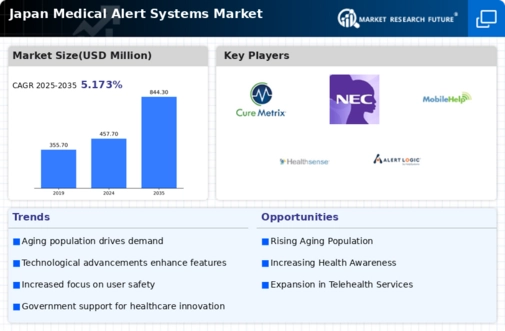Aging Population Demographics
Japan's demographic landscape is characterized by a rapidly aging population, which significantly influences the medical alert-systems market. As of 2025, approximately 28% of the population is aged 65 and older, a figure projected to rise in the coming years. This demographic shift necessitates enhanced healthcare solutions, including medical alert systems, to ensure the safety and well-being of elderly individuals. The increasing prevalence of chronic conditions among older adults further drives demand for these systems, as they provide timely assistance in emergencies. Consequently, the medical alert-systems market is likely to experience substantial growth, with estimates suggesting a market value exceeding $1 billion by 2027. This trend underscores the critical need for innovative solutions tailored to the unique requirements of Japan's aging citizens.
Government Initiatives and Support
Government initiatives aimed at improving healthcare access and safety are playing a crucial role in the medical alert-systems market. In Japan, various policies and programs have been implemented to promote the use of assistive technologies for the elderly. For instance, subsidies and financial assistance for purchasing medical alert systems are becoming more common, making these devices more accessible to a broader audience. As of 2025, it is estimated that government support has contributed to a 20% increase in the adoption of medical alert systems among seniors. This trend indicates a strong commitment from the government to enhance the quality of life for its aging population, thereby fostering growth in the medical alert-systems market. The continued emphasis on healthcare innovation and support is likely to sustain this upward trajectory in the coming years.
Rising Awareness of Health and Safety
There is a growing awareness of health and safety among the Japanese population, which is positively impacting the medical alert-systems market. Public health campaigns and educational initiatives have heightened the understanding of the importance of immediate assistance in emergencies, particularly for the elderly and those with chronic illnesses. As of 2025, surveys indicate that approximately 75% of older adults are aware of the benefits of medical alert systems, leading to increased adoption rates. This heightened awareness is likely to drive market growth, as families seek to ensure the safety of their loved ones. Furthermore, the medical alert-systems market is expected to expand as more individuals recognize the value of proactive health management, potentially increasing market penetration by 15% over the next few years.
Technological Advancements in Healthcare
The medical alert-systems market is significantly influenced by ongoing technological advancements in healthcare. Innovations such as wearable devices, mobile applications, and telehealth services are transforming how medical alert systems operate. In Japan, the integration of IoT (Internet of Things) technology into these systems enhances their functionality, allowing for real-time monitoring and communication. As of 2025, it is estimated that over 60% of medical alert systems incorporate advanced technology, improving user experience and reliability. This trend not only increases the appeal of medical alert systems among consumers but also encourages healthcare providers to adopt these solutions as part of their service offerings. The continuous evolution of technology in the medical alert-systems market is expected to drive further growth, with a projected annual increase of 10% in market size over the next five years.
Increased Focus on Home Healthcare Solutions
The shift towards home healthcare solutions is significantly impacting the medical alert-systems market. As more individuals prefer to receive care in the comfort of their homes, the demand for medical alert systems that facilitate this trend is on the rise. In Japan, the home healthcare market is projected to grow at a CAGR of 8% through 2027, driven by the desire for personalized care and independence among the elderly. Medical alert systems are increasingly viewed as essential tools that empower individuals to manage their health while remaining at home. This growing preference for home-based care solutions is likely to propel the medical alert-systems market forward, as families seek reliable systems that ensure safety and prompt assistance in emergencies.
















Leave a Comment